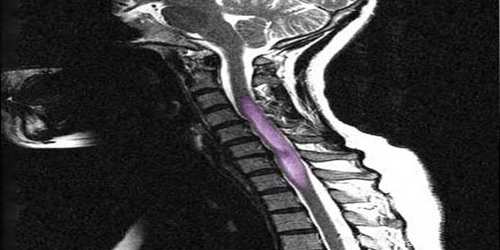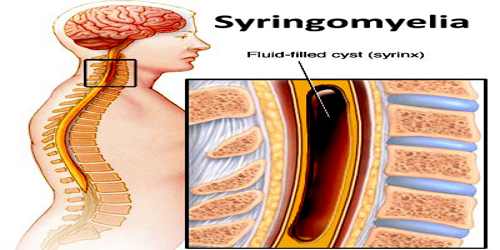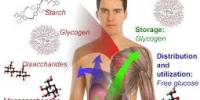Syringomyelia
Definition
Syringomyelia is a chronic disease of the spinal cord characterized by the presence of fluid-filled cavities and leading to spasticity and sensory disturbances. It is also called hydrosyringomyelia, Morvan’s disease. Syringomyelia may also cause a loss of the ability to feel extremes of hot or cold, especially in the hands. There is also a disorder that generally leads to a cape-like bilateral loss of pain and temperature sensation along the back and arms. Each patient experiences a different combination of symptoms. These symptoms typically vary depending on the extent and, often more critically, to the location of the syrinx within the spinal cord.

Syringomyelia is most common in adults aged 20 to 40, but it can happen to people of all ages. Men are more likely to get it than women. Some people don’t have symptoms, and might not even know they have it. But if it’s a severe case, it causes problems that need to be treated. It has a prevalence estimated at 8.4 cases per 100,000 people, with symptoms usually beginning in young adulthood. Signs of the disorder tend to develop slowly, although sudden onset may occur with coughing, straining, or myelopathy.
Causes, Sign and Symptom of Syringomyelia
Most cases of syringomyelia are caused by a malformation of the brain known as a Chiari type 1 malformation (CM1). A CM1 occurs where the brain joins the spinal cord. In this malformation, the brainstem lies lower than normal. Located at the back of the brainstem is the cerebellum. Often the bases of each lobe of the cerebellum, or the cerebellar tonsils, protrude from the skull and into the spinal canal.
Generally, there are two forms of syringomyelia: congenital and acquired. In addition, one form of the disorder involves the brainstem. The brainstem controls many of our vital functions, such as respiration and heartbeat. When syrinxes affect the brainstem, the condition is called syringobulbia.

Syringomyelia symptoms usually develop slowly over time. In some cases, coughing or straining may trigger symptoms of syringomyelia, although neither causes syringomyelia. The following early signs and symptoms of syringomyelia may affect the back of our neck, shoulders, arms and hands first:
- Muscle weakness and wasting (atrophy)
- Loss of reflexes
- Loss of sensitivity to pain and temperature
Other signs and symptoms of syringomyelia may include:
- Stiffness in our back, shoulders, arms and legs
- Pain in our neck, arms and back
- Bowel and bladder function problems
- Muscle weakness and spasms in our legs
- Spinal curvature (scoliosis)
If patient have had a spinal injury, it’s important to watch for these symptoms. It may take months or even years after their injury for syringomyelia to develop.

Treatment of Syringomyelia
An MRI of patient’s spine and spinal cord is the most reliable tool for diagnosing syringomyelia. An MRI uses radio waves and a strong magnetic field to produce detailed images of their spine and spinal cord. If a syrinx has developed within patient’s spinal cord, doctor will be able to view it on the MRI. A CT scan also uses a series of X-rays to create a detailed view of patient’s spine and spinal cord.

Treatment depends on the progression of the disorder and whether patients are experiencing symptoms that disrupt their life. If they have no symptoms or mild symptoms, they won’t need treatment. A neurologist will monitor the progression of the disorder.
If patient’s symptoms are negatively affecting their life, then neurologist will recommend surgery. The goal of surgery is to relieve the pressure on their spinal cord. The type of surgery will depend on the cause of their syringomyelia.
Surgery doesn’t always effectively restore the flow of cerebrospinal fluid, and the syrinx may remain, despite efforts to drain the fluid from it. The syrinx may grow over time, requiring additional treatment. Even after treatment, some signs and symptoms of syringomyelia may remain, as a syrinx can cause permanent spinal cord and nerve damage.
Reference:
















